
Hieracium , known by the common name hawkweed and classically as hierakion, is a genus of flowering plant in the family Asteraceae, and closely related to dandelion (Taraxacum), chicory (Cichorium), prickly lettuce (Lactuca) and sow thistle (Sonchus), which are part of the tribe Cichorieae. Hawkweeds, with their 10,000+ recorded species and subspecies, do their part to make Asteraceae the second largest family of flowering plants. Some botanists group all these species or subspecies into approximately 800 accepted species, while others prefer to accept several thousand species. Since most hawkweeds reproduce exclusively asexually by means of seeds that are genetically identical to their mother plant, clones or populations that consist of genetically identical plants are formed and some botanists prefer to accept these clones as good species whereas others try to group them into a few hundred more broadly defined species. What is here treated as the single genus Hieracium is now treated by most European experts as two different genera, Hieracium and Pilosella, with species such as Hieracium pilosella, Hieracium floribundum and Hieracium aurantiacum referred to the latter genus. Many members of the genus Pilosella reproduce both by stolons and by seeds, whereas true Hieracium species reproduce only by seeds. In Pilosella, many individual plants are capable of forming both normal sexual and asexual (apomictic) seeds, whereas individual plants of Hieracium only produce one kind of seeds. Another difference is that all species of Pilosella have leaves with smooth (entire) margins whereas most species of Hieracium have distinctly dentate to deeply cut or divided leaves.
A dry roadside dotted with small, ¾ inch red orange flowers, interspersed with very similar yellow ones, and often the white of daisies, is a good sign that you are in Hawkweed country.

Allium canadense, the Canada onion, Canadian garlic, wild garlic, meadow garlic and wild onion is a perennial plant native to eastern North America from Texas to Florida to New Brunswick to Montana. The species is also cultivated in other regions as an ornamental and as a garden culinary herb. The plant is also reportedly naturalized in Cuba.
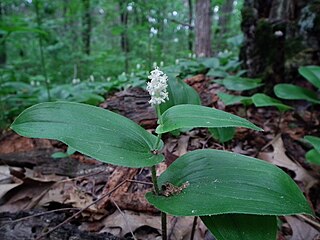
Maianthemum canadense is an understory perennial flowering plant, native to Canada and the northeastern United States, from Yukon and British Columbia east to Newfoundland, into St. Pierre and Miquelon. It can be found growing in both coniferous and deciduous forests. The plant appears in two forms, either as a single leaf rising from the ground with no fruiting structures or as a flowering/fruiting stem with 2-3 leaves. Flowering shoots have clusters of 12–25 starry-shaped, white flowers held above the leaves.
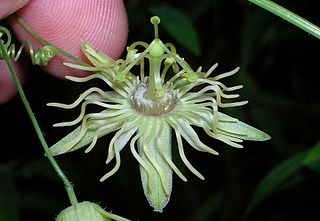
Passiflora lutea, commonly known as yellow passionflower, is a flowering perennial vine in the family Passifloraceae, native to the central and eastern United States. The vine has three-lobed leaves and small, yellowish-green, fringed flowers that appear in the summer, followed by green fruit that turn almost black at maturity. It grows in moist to wet habitats.

Anemonastrum canadense, synonym Anemone canadensis, the Canada anemone, round-headed anemone, round-leaf thimbleweed, meadow anemone, windflower, or crowfoot, is a herbaceous perennial flowering plant in the family Ranunculaceae. It is native to moist meadows, thickets, streambanks, and lakeshores in North America, spreading rapidly by underground rhizomes. It is valued for its white flowers.

Desmodium canadense is a species of flowering plant in the legume family, Fabaceae. It is native to eastern North America. Its common names include showy tick-trefoil, Canadian tick-trefoil, and Canada tickclover.

Verbascum blattaria, the moth mullein, is a flowering biennial plant belonging to the figwort family Scrophulariaceae. A native of Eurasia and North Africa, it has naturalized in the United States and most of Canada since its introduction and has become an invasive species there. It has been declared a noxious weed by the state of Colorado.

Nothocalais troximoides is a species of flowering plant in the family Asteraceae known by the common name sagebrush false dandelion. It is native to western North America, including British Columbia and the northwestern United States.
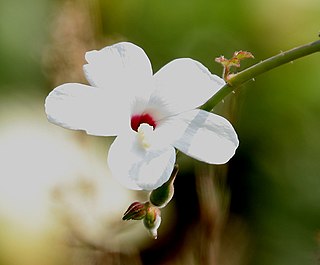
Abelmoschus ficulneus is a species of flowering plant in the genus Abelmoschus, family Malvaceae. Commonly known as white wild musk mallow or native rosella, it is fibrous perennial with a woody stem. Its flowers are about an inch in diameter, either pink or white, with a rose center; its leaves are palmate.
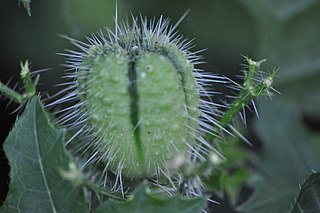
Cnidoscolus texanus, commonly known as Texas bullnettle, tread-softly, mala mujer, and finger rot, is a perennial herb covered with stinging hairs. The main stem, branches, leaves, and seed pods are all covered with hispid or glass-like bristly hairs that release an allergenic toxin upon contact. Contact with the plant results in intense pain: stinging, burning, and itching lasting for hours. It is native to the U.S. states of Texas, Arkansas, Kansas, Louisiana, and Oklahoma and also native to the northeastern state of Tamaulipas, Mexico. It is an herbaceous flowering plant that grows between 30–80 cm (11.8–31.5 in) tall and as much as 1 m (3.3 ft) across. Texas bullnettle has showy, fragrant white flowers that can bloom throughout the year in southern regions of its distribution, predominantly March to November in northern regions. It is a drought-tolerant plant, therefore making it a superb choice for xeriscaping. This plant is attractive to birds, bees, butterflies, and other insects. The seeds are known to be consumed by Rio Grande wild turkeys and mourning doves.

Tricardia is a monotypic genus of flowering plants in the borage family containing the single species Tricardia watsonii, which is known by the common name threehearts. It is native to the southwestern United States, where it grows in deserts and mountains in sandy open habitat, often beneath shrubs. It is a perennial herb growing from a taproot and a woody caudex covered with the shreddy remains of previous seasons' herbage. It produces several erect stems up to about 40 centimeters tall. Most of the leaves are located in a basal rosette about the caudex. They are lance-shaped and coated thinly in woolly hairs. They are up to 9 centimeters long and are borne on petioles. A few smaller leaves occur higher on the stem. Flowers occur in a loose cyme at the top of the stem. Each has a calyx of five sepals. The outer three are heart-shaped and green to pink or purple in color, and the inner two are much smaller and narrower. The flower within is bell-shaped, white with central purple markings, and roughly half a centimeter wide. The fruit is a capsule just under a centimeter long which contains 4 to 8 seeds.

Solidago albopilosa is a rare species of flowering plant in the family Asteraceae known by the common name whitehair goldenrod.

Solidago ouachitensis is a North American species of flowering plants in the family Asteraceae known by the common name Ouachita Mountain goldenrod. It has a very limited range, found only in the Ouachita Mountains along the border between Arkansas and Oklahoma in the United States.

Symphyotrichum georgianum is a rare species of flowering plant in the Asteraceae, the aster family. Its common name is Georgia aster. It is native to the southeastern United States where it is known from Alabama, Florida, Georgia, North Carolina, and South Carolina. As of 2013, it may be extirpated from the state of Florida.

Verbesina virginica, known by the common names white crownbeard, or frostweed is a species of flowering plant in the family Asteraceae. It is native to the Southeastern United States, where it is found in calcareous soil, often in bottomland thickets and edges of woods.

Hypericum boreale, also known as northern St. John's-wort, is a short-lived perennial species of flowering plant in the family Hypericaceae, section Trigynobrathys.

Teucrium canadense, commonly known as Canada germander, American germander, or wood sage, is a perennial herb in the family Lamiaceae. It is native to North America where it is found across the contiguous states of the United States and in much of Canada.

Verbena stricta, also known as hoary verbena or hoary vervain, is a small purple wildflower native to a large region of the central United States.

Hypericum canadense, known as Canadian St. Johns-wort, lesser St. John's wort, and lesser Canadian St. Johnswort, is a flowering plant in the genus Hypericum. It is a yellow-flowering annual or perennial herb native to North America and introduced to Ireland and The Netherlands. The specific epithet canadense means "Canadian".
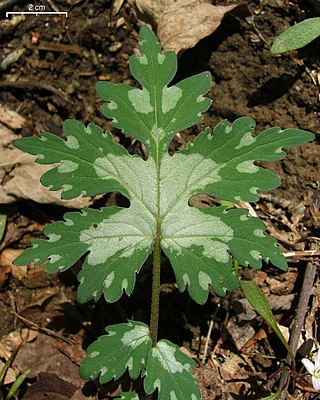
Hydrophyllum canadense, known as bluntleaf waterleaf, broadleaf waterleaf, or Canada waterleaf, is a flowering plant in the borage family, Boraginaceae. It is native to the eastern United States and Canada.




















